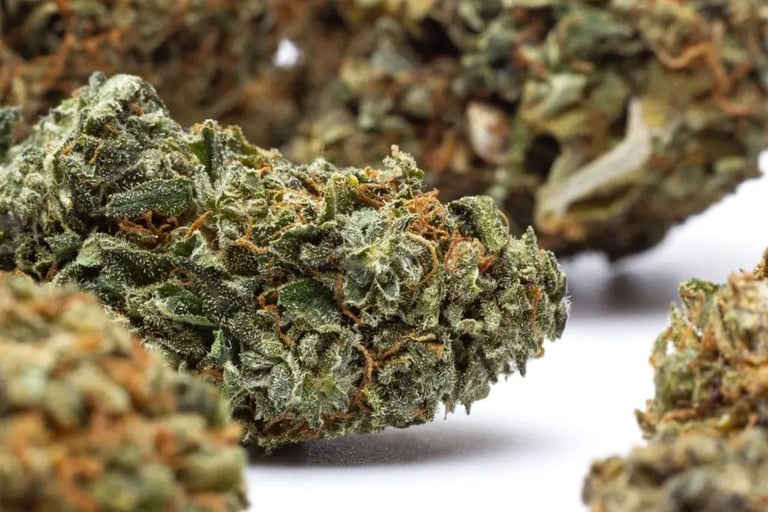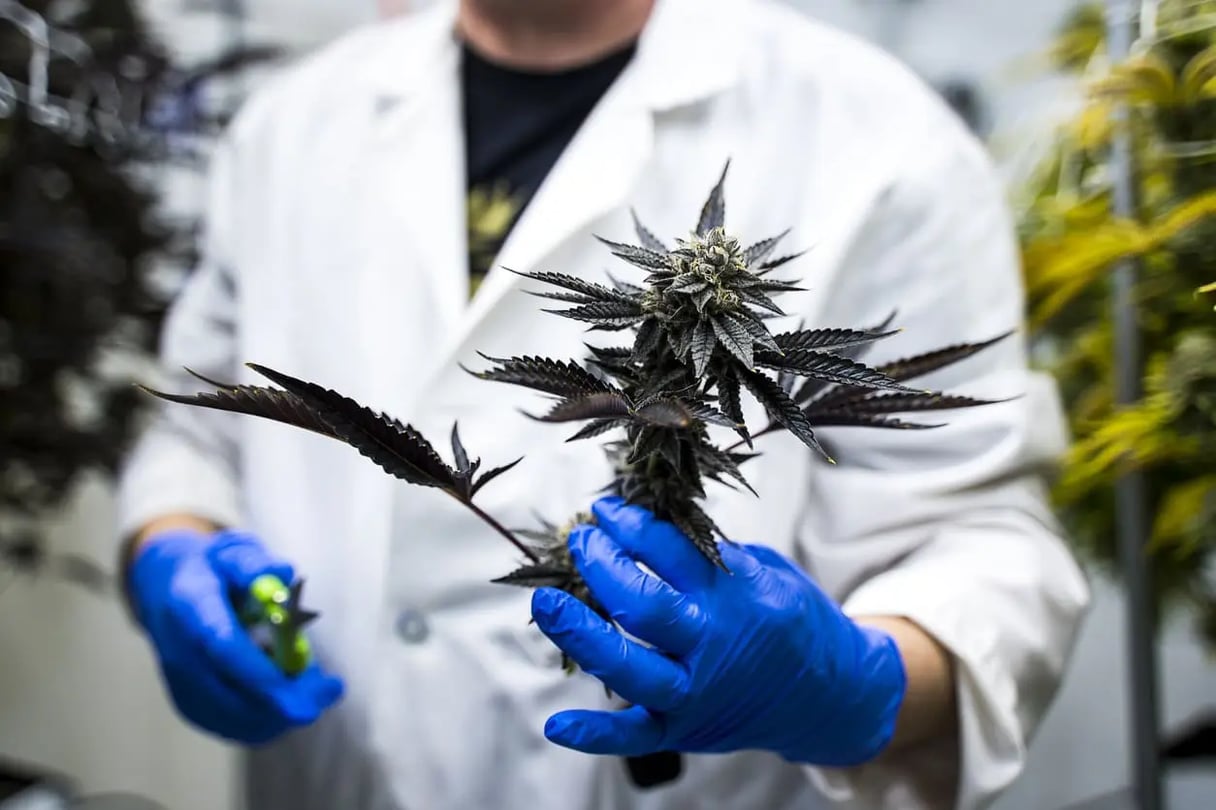
Want to Learn More About Cannabis Terpenes?
Explore the intricate world of terpenes; delve into their fascinating functionalities, and discover the diverse effects they offer.
Introduction
The world of cannabis is rich with a myriad of compounds that contribute to its unique characteristics and effects. Among these, sabinene is a terpene that has garnered less attention than its more well-known counterparts, yet it holds a potentially impactful presence within the spectrum of cannabis terpenes. This analysis aims to demystify sabinene, examining its contributions to the aromatic nuances, the potential therapeutic applications, and the all-important entourage effect in cannabis varieties. By exploring the subtleties of sabinene’s role, we can advance our comprehension of terpene effects and how they amplify the cannabis experience.
Key Takeaways
Sabinene is a complex terpene with a unique aroma that contributes to the cannabis sensory experience.
Understanding the interaction between sabinene and other cannabis compounds is essential for appreciating the full scope of terpene effects.
Research into sabinene can enrich our knowledge of the entourage effect in cannabis, potentially leading to more effective therapeutic applications.
The diverse chemical makeup of sabinene may hold untapped benefits, accentuating the need for further scientific exploration.
Sabinene’s nuanced presence can influence the differentiation of cannabis strains and the market’s approach to product development.
Consumer demand for rich terpene profiles is guiding the evolution of cannabis products, with sabinene playing an integral role.
Understanding Terpenes in Cannabis
The world of cannabis is rich with aromatic compounds that define each strain’s unique character. Terpenes, specifically, are the organic molecules primarily responsible for these enticing aromas and flavours. They are found in the resinous glands of the cannabis plant, where they play a pivotal role in cannabis strain differentiation. The variety of terpene profiles in cannabis is a tapestry of scents ranging from citrusy to earthy, contributing to the plant’s sensory appeal.
However, these compounds do more than just provide an olfactory experience. Terpenes interact with cannabinoids, such as THC and CBD, in a synergistic ballet known as the entourage effect. This interaction often amplifies the cannabinoids’ effects on the human body, influencing everything from mood to pain perception.
Limonene, a terpene characterised by its refreshing citrus scent, is attributed with uplifting properties that may perk up the senses.
Myrcene, with its musky and earthy notes, is reported to have sedative effects, often sought after for relaxation.
Pinene, reminiscent of pine forests, is believed to have energizing properties that could help increase alertness.
Understanding these complex relationships is essential as researchers delve deeper into the way these aromatic compounds influence both our mental and physical well-being. As the cannabis industry evolves, the knowledge of terpene profiles will become increasingly significant, ensuring consumers are well-informed and cultivators are equipped to grow strains that cater to specific experiences and medicinal benefits.
The Molecular Makeup of Sabinene Terpene
Delving into the complexities of sabinene reveals its nuanced role within the aromatic profiles of both cannabis and other botanicals. As a secondary terpene, sabinene’s molecular characteristics are less obvious than primary terpenes yet offer a substantial contribution to a strain’s overall sensory experience. A deeper understanding of its molecular structure sheds light on the therapeutic potential and applications in cannabis products.
The cornerstone of sabinene structure is its isoprenoid framework, a chain of isoprene units that is a hallmark of terpene biosynthesis. This intricate structure is responsible for sabinene’s signature scent, identified by a spicy and earthy aroma, with subtle hints of citrus. Beyond cannabis, sabinene graces the essence of Norway spruce and black pepper, evidencing its widespread presence in nature.
Molecular Characteristics: Sabinene’s unique molecular configuration, which comprises a bicyclic monoterpenoid arrangement, allows it to engage in multiple interactions with other compounds, enhancing its potential benefits.
Terpene Biosynthesis: The formation of sabinene via biosynthesis involves enzymatic reactions that intricately convert simple organic precursors into more complex terpenoid compounds. This process underpins the diversity of terpenes in the plant kingdom.
Plant Diversity and Healing Properties: Found in a breadth of plant species, sabinene is noted for its potential healing properties, such as anti-inflammatory and antimicrobial effects, that transcend the world of cannabis.
By unpacking the molecular makeup and terpene biosynthesis of sabinene, researchers and industry experts can pave the way for innovative applications that harness its full spectrum of effects. The information gathered on sabinene not only enriches our understanding of terpenes but also assists in sculpting the future landscape of cannabis product development and use.
Interactions and Synergy: Terpenes and Cannabinoids
The complexity of cannabis is epitomised by the entourage effect, which highlights the terpene-cannabinoid synergy that is pivotal to the plant’s influence on users. Beyond the isolated impact of THC or CBD, the collaboration of these cannabis compounds results in a multifaceted interaction akin to an orchestra, where each element contributes to a harmonious outcome that surpasses the capabilities of individual compounds.
Sabinene, albeit less prominent than some other terpenes, plays a significant role in this interplay, offering nuances that could potentially elevate the medicinal and therapeutic benefits of cannabis compounds. Researchers are investing considerable effort to demystify the ways in which sabinene interacts with other cannabinoids, suggesting a future where its specific contributions to the entourage effect are not only recognised but actively sought after.
Understanding how sabinene influences the efficacy of cannabinoids.
Exploring full-spectrum concentrates that offer an enriched cannabis experience.
Investigating potential formulations that leverage sabinene’s unique properties.
The consumer shift towards full-spectrum products illustrates an informed desire for compounds that work in concert rather than isolation. Among these compounds, sabinene’s collaboration with cannabinoids has opened a new chapter in the narrative of cannabis, which continues to intrigue and inspire the scientific community and industry innovators alike.
Aromatic Contributions: Sabinene’s Role in Cannabis Aroma
The sabinene scent profile is a remarkable aspect of its identity within the pantheon of aromatic terpenes in cannabis. This secondary terpene imparts an olfactory essence that is both complex and captivating, underscoring the sophisticated nuances that excite the discerning enthusiast. Its aroma has been described as a confluence of spicy, woody, and peppery notes—a harmony that underscores the diversity of cannabis experiences.
The importance of sabinene in differentiating strains cannot be overstated, as aroma plays a pivotal role in the consumer decision-making process. Those with well-developed senses can ascertain the quality and traits of a strain based on its scent alone. The concentration of sabinene significantly affects its aromatic signature, suggesting that even slight variations in its presence can alter a strain’s appeal.
Preservation of sabinene during cultivation is crucial to maintaining its scent integrity.
Extraction techniques are tailored to retain the full spectrum of terpenes, including delicate compounds like sabinene.
Cultivators and producers are increasingly attentive to the olfactory preferences of the market.
In essence, the value of sabinene extends beyond its individual aromatic characteristics to contribute substantially to the broader sensory palette of the best weed strains, enhancing the consumer journey with every inhalation. It exemplifies the intricate dance of flavours and fragrances that define the cannabis spectrum, and its presence is a testament to the plant’s enigmatic allure.
Therapeutic Properties of Sabinene: Potential Health Benefits
The exploration into the health benefits attributed to medical cannabis has led researchers to place a spotlight on sabinene, a terpene with a noteworthy therapeutic potential. Among the myriad of organic compounds in cannabis, sabinene’s anti-inflammatory properties stand out, proposing significant implications for health and well-being. Additionally, its antibacterial effects tout an impressive profile, akin to benefits observed in other similar terpenes.
Potential to reduce inflammation and alleviate pain.
May offer antibacterial qualities, paving the way for alternative infection treatments.
Could act as an appetite suppressant, contributing to weight management.
Inherent capabilities to potentially enhance pain relief strategies.
Current studies involving sabinene are assessing its full range of medicinal properties, with early indicators pointing towards a versatile role within the wellness domain of the cannabis industry. The nuanced approach to understanding sabinene’s benefits may result in tailored health solutions, focusing on inflammation control, bacterial infection management, and potentially broadening to a spectrum of health conditions.
Continuing research to elucidate the extent of sabinene’s health benefits.
Integration of sabinene’s therapeutic properties into new cannabis product developments.
Consideration of sabinene in formulations targeting specific health concerns.
By integrating sabinene into wellness-focused medical weed strains and products, there is a promising opportunity to craft solutions that leverage its therapeutic qualities. It could herald a new suite of health-oriented applications and foster innovation in a sector that is rapidly expanding to meet the nuanced demands of consumers seeking naturalistic remedies.

Sabinene in Cannabis Strains: A Search for Rarity
The quest for sabinene-rich strains within the cannabis industry is a testament to the ever-evolving complexity of terpene chemistry and strain analysis. Despite its relative scarcity, sabinene is a terpene that commands attention due to its unique aromatic contributions and potential therapeutic effects. Its infrequent occurrence has made it all the more desirable, akin to a hidden gem amongst the more common terpenes. Sativa and indica options both may contain sabinene, as do some hybrid weed strains.
Research in the field of terpene chemistry has underscored the significance of conducting meticulous strain analysis to identify and catalogue the presence of sabinene. By delving deep into the genetic profiles of various cannabis cultivars, scientists and breeders are unlocking the secrets of this elusive terpene. The insights gained not only enrich our understanding but also guide the intentional cultivation of sabinene-enhanced strains. Below, we explore various elements that emphasise the rarity of sabinene and its implications for the cannabis market.
Identification of strains with prominent concentrations of sabinene, a pursuit engaging both connoisseurs and researchers alike.
Enhancement of breeding techniques to favour the growth of sabinene-rich strains, satisfying the desire for diversity within the aromatic spectrum of cannabis.
Comprehension of the ecological roles that sabinene fulfils in the natural world, informing sustainable and informed approaches to cultivation.
Understanding of how sabinene’s intricate terpene chemistry impacts the overall entourage effect within cannabis, providing unique sensory and medicinal profiles.
The future of cannabis strain development holds exciting potential for those strains offering a rich olfactory experience, underscored by the presence of sabinene. As our knowledge deepens, the industry is poised to welcome a new echelon of sabinene-focused offerings, promising unique experiences to consumers and patients. Such advancements serve not only to propel the industry forward but also to cater to the nuanced needs of a marketplace that is increasingly informed and discerning.
The Entourage Effect Explained: Completing the Cannabis Puzzle
At the heart of the cannabis plant’s therapeutic prowess lies a compelling phenomenon known as the entourage effect. This intricate synergy, where the whole becomes greater than the sum of its parts, is the essence of a full-spectrum experience. It’s shaped by the holistic effects that result from the cannabinoid-terpene interplay, a nuanced dance between compounds that is widely considered more effective for a myriad of conditions than any single isolated substance.
The entourage effect is not merely a theory but a foundation for understanding how cannabis exerts its effects so diversely. By delving into the cannabinoid-terpene interplay, science is beginning to unravel how each component of the cannabis plant contributes to its overall efficacy. It’s in this delicate balance of elements where sabinene, despite being less prominent, plays a critical role in enhancing the therapeutic profile of cannabis.
Cannabinoids, such as THC and CBD, represent the pillars of cannabis’ therapeutic effects.
Terpenes like sabinene add nuance through their unique aromas and potential health benefits.
Other aromatic compounds round off the sensory and beneficial attributes of the cannabis plant.
By encouraging a deeper comprehension among both consumers and healthcare professionals, the entourage effect fortifies its position as a beacon for those navigating the vast complexities of cannabis products. In pursuit of the holistic benefits cannabis offers, the quest for products and strains with a balanced, complete profile is intensifying. Individuals empowered with knowledge about the entourage effect are more likely to experience the full potential of their cannabis-based treatments, recognising the essential contribution of each component in this botanical ensemble.
Consumer Interest: How Sabinene is Shaping Cannabis Product Development
In the realm of cannabis consumption, the wave of consumer demand for terpenes has been profoundly influential on emerging cannabis market trends. Of particular note is sabinene, a once-overlooked terpene now coming to the fore as its potential is being tapped into by producers and savoured by consumers. Awareness of sabinene’s presence and its unique contributions to the aromatic and therapeutic aspects of cannabis has influenced not only product innovation but also consumer expectations and preferences.
Encouraged by the versatility of sabinene, pioneers in the cannabis industry are actively refining their processing techniques to conserve terpenes, understanding that their retention is paramount in meeting consumer needs. As a result, an impressive variety of sabinene-rich products is entering the market. These innovative offerings are not restrained to a particular category; they span a broad spectrum from highly targeted tinctures and oils to bespoke edibles, each promising distinct experiences and wellness benefits catering to a discerning audience.
This seismic shift towards product differentiation rooted in terpene profiles signals a maturation of the marketplace. Sabinene’s role in this transformation extends beyond adding more depth to the consumer experience; it also underscores the importance of minor terpenes in customising effects and therapeutic outcomes. Consequently, sabinene is not only influencing current production practices but is also galvanising a future wherein the nuanced complexities of cannabis can be explored and enjoyed in full measure. This is a testament to how consumer interest can drive innovation, steering us towards a more diverse and enriched future for cannabis products.
Sabinene FAQs:
-
Sabinene is a lesser-explored terpene found in cannabis that contributes to the unique aromas of certain strains. It’s important for both its potential therapeutic properties and its role in differentiating cannabis strains through its distinctive scent, influencing the overall flavour and experience of cannabis consumption.
-
Terpenes, including sabinene, interact synergistically with cannabinoids such as THC and CBD to enhance their effects. This interplay, known as the entourage effect, can lead to a more complex and potentially beneficial therapeutic experience when consuming cannabis products.
-
Sabinene has a distinctive spicy, woody, and peppery scent that adds nuance to the aromatic profile of cannabis strains. It enriches the olfactory essence and assists in distinguishing between strains, offering a more refined sensory experience.
-
As awareness of sabinene and its benefits increases, it influences market trends and product development. Producers are focusing more on terpene retention and developing sabinene-centric products to meet the nuanced demands of consumers, leading to a diversification of offerings that highlight sabinene’s unique properties.
-
Sabinene is relatively uncommon in cannabis strains, which can add an element of rarity and desirability. Strains that contain higher levels of sabinene might offer unique aromatic profiles and potential health benefits, making them particularly appealing to consumers with refined tastes or specific therapeutic needs.












.jpg)